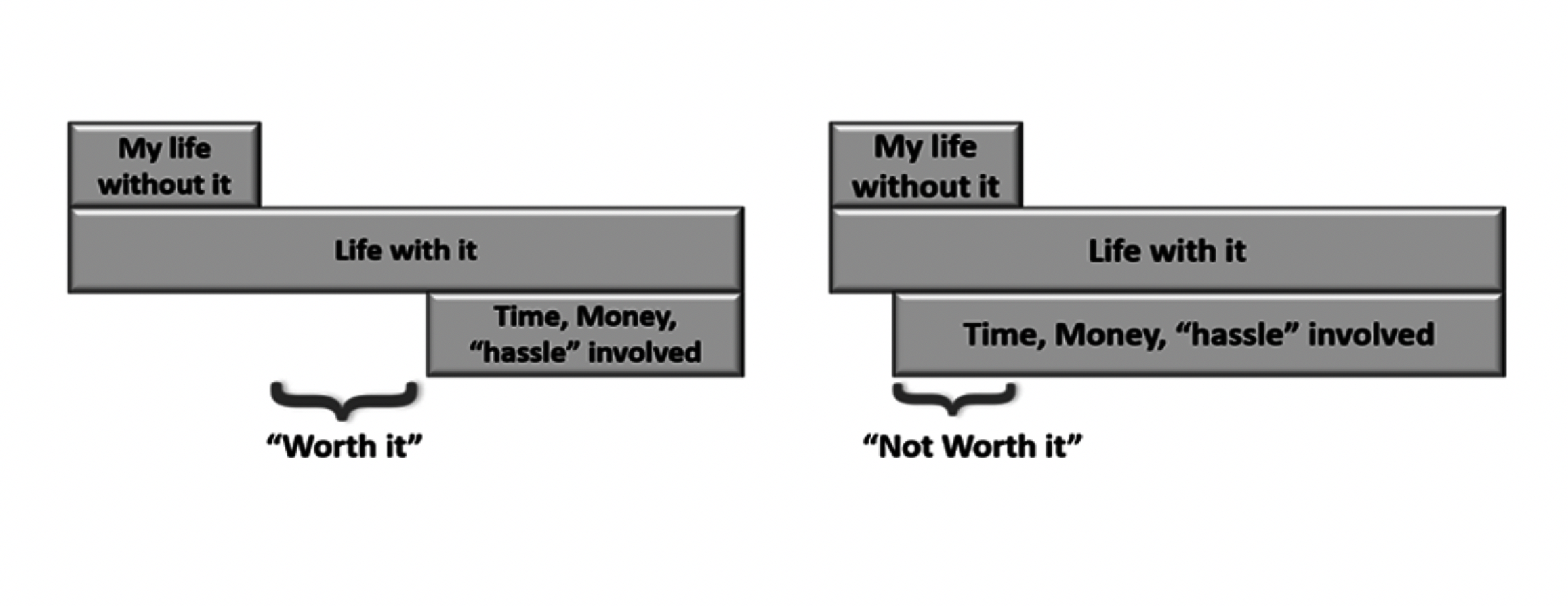The first guiding principle of the ITIL 4 framework, "Focus on value," sounds simple enough, but there's considerably more to that statement than meets the eye.
Value includes five core elements, described below, and some other intangible factors, including people, combined expertise of management and staffers, and company culture.
The good news is that you can change your company's value proposition, and your own, by working on these individual elements. By doing so, you can make your work more meaningful to yourself and your customers.
Here are the essential components that make up your company's value, and how you can work on them.
What is value?
ITIL 4 defines value as "the perceived benefits, usefulness and importance of something," so the value of anything comes from those receiving it. So it is those receiving it who determine the value of something. Value, like beauty, is in the eye of the beholder.
Something (or someone) has value if a person determines that it is "worth it" to them. If you believe something is worth it to you, it has value. If you believe it has no value to you, then it doesn't. It's as simple as this:
Source: Ken Wendle and Edify ITSM, Inc.
There are degrees of value—or lack thereof. Something can be of little value, quite a bit of value, or of tremendous value. Alternately, something can be of no value or even negative value. Not only is it not worth it; it's really not worth it!
Albert Einstein once said, "Try not to become a person of success but rather try to become a person of value." This quote was the genesis of my book, The V*A*L*U*E Formula. Einstein explained that someone is considered successful who gets more out of life than he or she puts in. But a person of value gives more than he or she receives.
The five elements of value
Throughout my career working with dozens of companies and scores of people, I've observed a few common threads when it comes to value, which I've distilled down into the five elements of the Value Formula in my book.
Here's a look at each element.
1. Vision
The first element is encapsulated within an organization's vision statement. Through a common vision, organizations establish a guiding star, so to speak, to give direction and to help guide and inspire everyone. That's why the model depicts vision as a star.
2. Alignment
This comes into play when you put your best efforts toward realizing your vision. Goals are set in support of the vision. Tasks are defined, assigned, and linked to the vision. It helps to ensure that any actions taken are effective, and they are done efficiently.
3. Leverage
Organizations that focus on value look for ways and means to augment their efforts. If you don't understand leverage, you're probably working too hard, because leverage can make a difficult job much easier and a seemingly impossible job possible.
Leverage is illustrated as a diamond-shaped cornerstone supporting alignment. It consists of a number of "facets" that represent categories of external resources and capabilities you can leverage, including processes, technologies, tools, and other organizations.
4. Uniqueness
This is also a diamond-shaped cornerstone that supports alignment. Organizations can—and should—discover and capitalize upon internal resources and capabilities to define their unique value proposition. It helps answer the question, "How do we differentiate ourselves?"
The facets of uniqueness include (among other things) the environment, policies, people, and culture, all of which are part of what makes us us.
In his book The Excellence Dividend, Tom Peters poses a powerful challenge: Differentiate or die.
5. Execution
In the pursuit of increasing value, the other elements are worthless if your organization can't execute consistently and successfully to deliver value. Having a bias toward taking action is critical and foundational. Execution, therefore, is the very foundation upon which the other four elements are built.
Understand your company's distinctiveness
Uniqueness is about determining that differentiation, your distinctiveness, that which sets you and your organization apart from everyone else.
The resources and capabilities that you possess at this moment—individually or organizationally—generally speaking, may be very similar to those of others. But the combination of these is completely unique to you.
In addition, values, beliefs, experiences, specific knowledge gained, relationships, and so on reinforce that there is no one quite like you. And there is no other organization quite like yours.
Uniqueness is the quality of being the only one of its kind. In realizing your value, it helps you gain an advantage by capitalizing on those internal resources and capabilities you possess that make you one of a kind.
People make the difference
One of the facets of uniqueness is people.
Something every organization, large and small, has in common is people. People are the single biggest differentiator regarding value. No one else has the special talents and capabilities of the people within a specific organization—even an organization of one.
Uniqueness comes from valuing and encouraging the special contributions made by people by recognizing and building talent.
People always make the difference.
A story illustrating this powerful truth appeared in Huffpost in 2013 about Joshua Wade, a nine-year-old boy who needed an endoscopy. Naturally, he brought his favorite stuffed animal, "Wolf," along to the hospital.
Wolf had a hole in his right leg, and so was in need of repair. The little boy asked Dr. Christine Waasorp Hurtado at Children's Hospital Colorado if she could also perform surgery on his stuffed buddy's injured leg.
When his parents heard his request, they said, "No, no, no, they don't do wolf surgeries here! We'll fix him when you get home."
But upon waking up from his surgery, Joshua discovered his stuffed friend was wearing a hospital mask and had a fresh set of sutures and a new bandage on his leg.
People ALWAYS make the difference.
Combined experience, and the work environment
The combined knowledge and experience of management, employees, and co-workers is very often much greater than we realize, and equally as often overlooked. Management often keep employees from being their best by limiting support, resources, and training.
On the other hand, even when management is willing to help, it doesn't always know how and may be waiting to be asked by employees, who may be reluctant to do so for any number of reasons.
Another facet of uniqueness is your work environment, which says a lot about you and your organization. In the opening scene of the Tom Hanks/Meg Ryan movie "Joe Versus the Volcano," legions of slack-jawed office drudges plod toward an intimidating dystopian building where, inside, dim fluorescent lights flicker in drab, windowless offices. No wonder Joe left. And he left to jump into an active volcano!
The physical appearance of your environment tells a story. What image does it communicate? How does it affect your employees, and what impression does it make to customers?
Is your work environment healthy? Look at the physical environment from a health and safety perspective. Employees (or customers) shouldn't have to worry about tripping over worn carpet or electric cables that aren't properly taped down. Or to have a piece of a cracked ceiling fall on their head!
Does anything stand out, positive or negative? Can the walls use a fresh coat of paint? Does anything need to be repaired or require a change in layout?
Plants thrive in a healthy environment. So do people!
Your organization's culture plays a key role
Culture is perhaps the most powerful facet of uniqueness.
It's been said that "culture eats strategy for breakfast," and nothing defines "who we are" as an organization more than your company's culture.
Your culture isn’t manifested through clever posters hanging in your hallways touting company values ("Hang in there, baby!"). To a significant degree, culture manifests itself through behavior.
What do the people who work within your organization do, and how do they do it? How do the people who work within your organization act? How do they behave toward their teammates, other employees, and your customers?
Culture is the unique, authentic personality of your organization. You can "sense" culture. Your culture may not be easy to put into words, but it manifests itself through the attitudes and behaviors of people: how they treat each other and how they treat customers, as well as what they focus on and what they say and what they do.
Listen to the stories and anecdotes people share. It’s one thing to proclaim, "Our staff is customer-focused." It's quite another to learn that Bob drove through the snowstorm to fix a customer's furnace on a weekend! It's one thing to declare, "We believe in teamwork," and quite another to hear that Greg from IT really came through in supporting Brenda's sales pitch.
When culture doesn't work
Recently, I went to visit a friend, the head of a not-for-profit organization that my wife and I have contributed to for years. While waiting in the lobby, I noticed they were selling raffle tickets as a fundraiser. I asked the administrative assistant if I could purchase tickets with a credit card, to which she replied, "No, only check or cash."
When I let out a bit of an exasperated sigh, she said, "Well, don't get upset with me. I've been doing her job all morning because she's out of the office," referring to the person in charge of the fundraiser.
Then she mentioned that there was a space on the raffle ticket itself for a credit card number so I asked for three. Seeing how small the space was for the credit card information, I asked if I needed to put the information on all three tickets. "Well," she replied, "I’m not going to do your work for you."
Maybe she was just having a bad day. Maybe she didn't realize her salary was paid by people like me supporting the organization. Regardless, it communicated something about the culture of the organization that just might need some attention.
Craft your own value vision
Take the time to think about and craft a value vision that inspires and motivates you. Next, commit and align your best efforts in the direction of that vision. Look for ways to augment those efforts through leverage, and differentiate yourself through your uniqueness.
And, finally, get to work to make it happen—execute!
To learn more about how to discover your uniqueness, come to my presentation at Fusion19, to be held October 7-10, 2019 in New Orleans, Louisiana. I'll be speaking at 1:45 pm on Tuesday.
Keep learning
Choose the right ESM tool for your needs. Get up to speed with the our Buyer's Guide to Enterprise Service Management Tools
What will the next generation of enterprise service management tools look like? TechBeacon's Guide to Optimizing Enterprise Service Management offers the insights.
Discover more about IT Operations Monitoring with TechBeacon's Guide.
What's the best way to get your robotic process automation project off the ground? Find out how to choose the right tools—and the right project.
Ready to advance up the IT career ladder? TechBeacon's Careers Topic Center provides expert advice you need to prepare for your next move.




